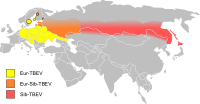
Photo from wikipedia
Tickborne diseases (TBDs) such as Lyme disease result in ≈500,000 diagnoses annually in the United States. Various methods can reduce the abundance of ticks at small spatial scales, but whether… Click to show full abstract
Tickborne diseases (TBDs) such as Lyme disease result in ≈500,000 diagnoses annually in the United States. Various methods can reduce the abundance of ticks at small spatial scales, but whether these methods lower incidence of TBDs is poorly understood. We conducted a randomized, replicated, fully crossed, placebo-controlled, masked experiment to test whether 2 environmentally safe interventions, the Tick Control System (TCS) and Met52 fungal spray, used separately or together, affected risk for and incidence of TBDs in humans and pets in 24 residential neighborhoods. All participating properties in a neighborhood received the same treatment. TCS was associated with fewer questing ticks and fewer ticks feeding on rodents. The interventions did not result in a significant difference in incidence of human TBDs but did significantly reduce incidence in pets. Our study is consistent with previous evidence suggesting that reducing tick abundance in residential areas might not reduce incidence of TBDs in humans.
Journal Title: Emerging Infectious Diseases
Year Published: 2022
Link to full text (if available)
Share on Social Media: Sign Up to like & get
recommendations!